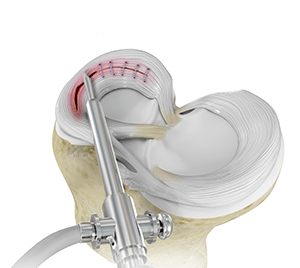
Meniscus
The meniscus is a C-shaped cartilage that functions as a cushion between the long bones of the shin and thigh. Forceful twisting of the knee while bearing weight on it can result in a torn meniscus. Small tears in the meniscus often heal with rest. Moderate tears on the outer edge of the meniscus tend to respond favorably to surgical repair. However, the deeper the tear, the less likely it is to heal after surgical repair. This is because the center of the meniscus has no blood supply when compared to the outer one-third of the meniscus.
Failed Meniscus Repair
Meniscal repair may be performed either by open surgery under direct vision or minimally invasively using an arthroscope, which is a thin tube fitted with a camera that can be inserted into the knee through a very small incision to locate and repair the damaged meniscus.
Three months following meniscal repair if pain and disability persist, a failed meniscal repair may be suspected and can be confirmed by performing a repeat arthroscopy.
Factors that may cause a failed meniscal repair include:
- Patients older than 40 years of age
- Delayed treatment
- Ragged, degenerative and complex tears
- Full-thickness tear
- Tears in the inner margin that lack blood supply
Following a failed meniscal repair, your doctor will recommend conservative therapy with pain medication and activity modification if the symptoms are minimal. If a residual tear is diagnosed, the meniscus may be trimmed before considering a second surgical repair of the meniscus.
Related Topics
- Knee Arthroscopy
- ACL Reconstruction
- Knee Cartilage Restoration
- Meniscal Surgery
- Patellofemoral Knee Replacement
- Meniscus Replacement
- Cartilage Replacement
- PCL Reconstruction
- Knee Ligament Reconstruction
- Posterolateral Corner (PLC) Reconstruction
- Revision Knee Ligament Reconstruction
- Posterolateral Corner Reconstruction
- LCL Reconstruction
- MCL Reconstruction
- LPFL Reconstruction
- Medial Patellofemoral Ligament Reconstruction
- Quadriceps Tendon Repair
- Knee Fracture Surgery
- Meniscectomy
- Distal Realignment Procedures
- Partial Arthroscopic Meniscectomy
- Patellofemoral Realignment
- Failed Anterior Cruciate Ligament (ACL) Reconstruction
- Failed Meniscus Repair
- Lateral Lengthening
- Meniscal Transplantation
- Prior Meniscectomy
- Tibial Eminence Fracture
- ORIF of the Knee Fracture
- Bone-Patellar Tendon-Bone (BPTB) Autograft
- Bone-Patellar Tendon-Bone (BPTB) Allograft
- Hamstring Autograft
- Hamstring Allograft
- Knee Osteotomy
- High Tibial Osteotomy
- Tibial Tubercle Osteotomy
- Distal Femoral Osteotomy
- Multiligament Reconstruction of the Knee
- Patellar Tendon Repair
- Arthroscopic Reconstruction of the Knee for Ligament Injuries
- Autologous Chondrocyte Implantation
- Partial Meniscectomy
- Cartilage Microfracture
- Pharmacological Interventions for Knee Injuries
- Ultrasound-Guided Genicular Nerve Block
- Intraarticluar Knee Injection
- Viscosupplementation
- Physical Therapy for Knee








